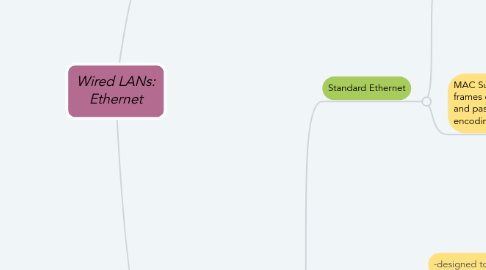
1. IEEE Standards
1.1. Project 802 - to set standard to enable intercommunication among equipment and a way if specifying functions of physical layer and data link layer.
1.2. Data link layer - divided into logical link control sublayer & medium access control (MAC) sublayer.
1.3. Physical layer - divided into physical layer signaling (PLS) sublayer, attachment unit interface (AUI), medium attachment unit (MAU) and medium dependent interface(MDI).
2. Standard Ethernet
2.1. Standard Ethernet
2.1.1. - was designed to operate at 10 Mbps
2.1.2. MAC Sublayer - governs the operation and frames data received from the upper layer and passes them to PLS sublayer for encoding
2.1.2.1. 1) Frame format - contains 7 fileds: preamble, start frame delimiter(SFD), destination address(DA), source address(SA), length of protocol data unit(PDU), data and the CRC
2.1.2.2. 2) Frame length - minimum frame is 64 bytes and maximum frame is 1518 bytes
2.1.2.3. 3) Addressing - each station has its own network interface card(NIC). NIC will provide the physical address(6 byte) - normally written in hexadecimal notation.
2.1.2.3.1. 1) unicast - frames comes from only one station
2.1.2.3.2. 2) unicast destination - address defines only one recipient (one-to-one)
2.1.2.3.3. 3) multicast destination- defines a group of addresses (one-to-many)
2.1.2.3.4. 4) broadcast destination - special address case of multicast address.
2.2. Fast Ethernet
2.2.1. -designed to operate at 100 Mbps
2.2.2. - access method is the same(CSMA/CD) but full duplex fast ethernet. - there is new feature is called autonegotiation (allow 2 devices to negotiate the mode or data rate.
2.2.3. Physical layer - made up of four sublayers: RS sublayer (passing of data in 4-bit format to MII, encoding and decoding), Medium-independent interface(MII) (replaces AUI and an improved interface), PHY sublayer (transceiver in fast ethernet) and Medium-dependent interface(MDI)(piece of hardware responsble for connecting the transceiver)
2.2.3.1. Common fast ethernet implementatiobs: - 100Base-TX, 100Base-FX and 100Base-T$
2.3. Gigabit Ethernet
2.3.1. -designed to operate at 1000 Mbps
2.3.2. Mac sublayer - has 2 distinctive aproaches medium access: - half-duplex using CSMA/CD or full duplex without CSMA/CD
2.3.3. Physical layer - made up by 4 sublayers:- RS, GMII, PHY and MDI
2.3.3.1. Gigabit Ethernet implementations :- 1000Base-X, 1000Base-LX, 1000Base-CX and 1000Base-T
2.4. Ten-Gigabit Ethernet
2.4.1. -designed to operate at 10,000 Mbps
2.4.2. Goals:- to upgrade the data rate to 10Gbps, make it compatible, use the same 48-bit address, use the same frame format, keep the same minimum and maximum frame length and allow interconnection
2.4.3. Physical layer:- designed for using fiber optic cable over long distance
2.4.3.1. Ten-Gigabit ethernet implementations:- 10G-BaseTX, 10G-BaseFX and 10G-BaseT4--====
